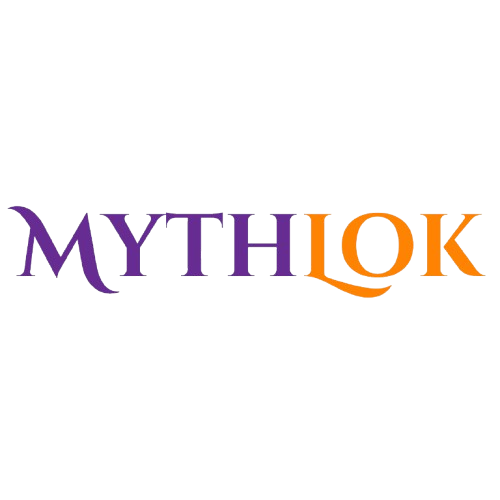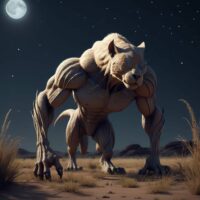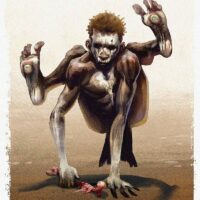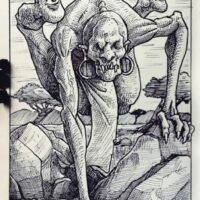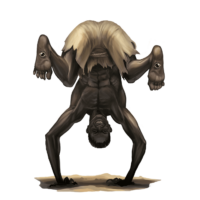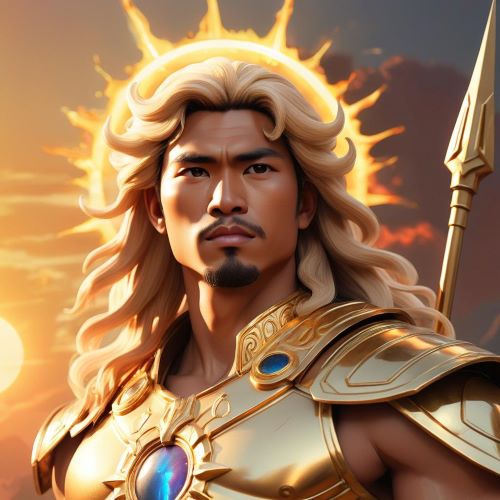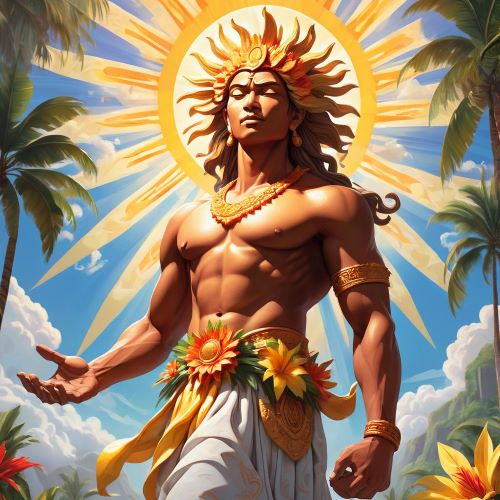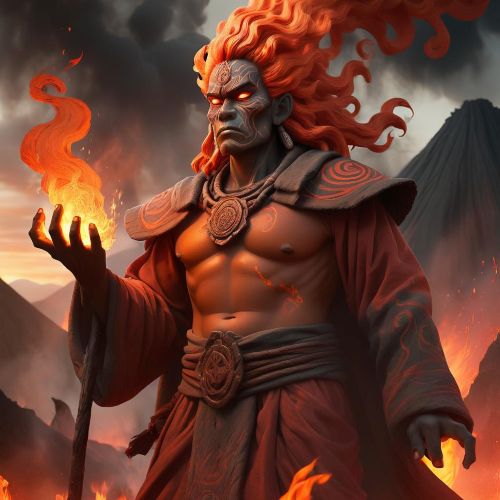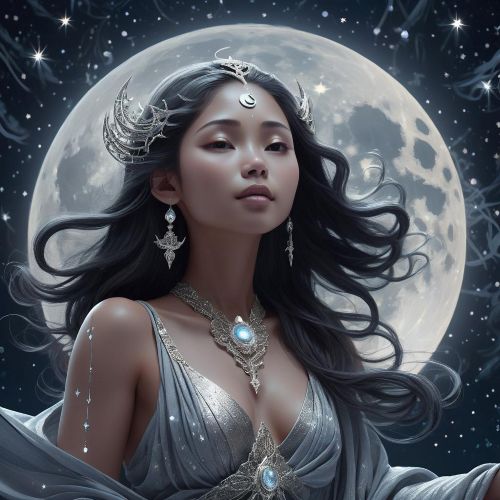Agueo : The Sun God
Listen
At a glance
| Description | |
|---|---|
| Origin | Philippine Mythology |
| Classification | Gods |
| Family Members | Ama (Father), Bulan (Brother) |
| Region | Philippines |
| Associated With | Sun |
Agueo
Introduction
Agueo is a prominent yet often overlooked deity in Philippine mythology, particularly among the Pangasinense people of Northern Luzon. Known as the god of the sun, Agueo plays a pivotal role in maintaining cosmic order by guiding daylight across the sky. While Philippine mythology features a vast pantheon of gods and spirits from over 140 ethnolinguistic groups, many such figures—Agueo included—have remained on the margins of mainstream recognition. His tale reflects deeper themes of obedience, cosmic duty, and the duality of divine siblings. Agueo’s legend, though limited in written sources, continues to intrigue those exploring the Philippines’ pre-colonial spiritual heritage.
Physical Traits
Descriptions of Agueo’s physical form are sparse, but his characteristics as a solar deity offer vivid symbolic imagery. He is envisioned as a radiant and composed figure, embodying the brilliance and constancy of the sun. His appearance is often interpreted metaphorically—glowing skin like sun-kissed gold, eyes that shine like midday light, and garments made of shimmering flame or light. Agueo’s presence is both warm and intimidating, suggesting a being of great power but also unwavering responsibility. His residence, a palace of pure light, further emphasizes his celestial nature and the reverence he commands in the mythological hierarchy.
Family
Agueo is the dutiful son of Ama, the supreme deity in Pangasinense cosmology and the father of all gods and humans. Ama, as the creator and ruler of the universe, commands immense respect and is responsible for assigning divine tasks to his offspring. Agueo’s sibling is Bulan, the moon god, whose playful and mischievous demeanor sharply contrasts Agueo’s stern disposition. This divine pairing represents the cosmic balance between day and night, light and shadow. When Bulan defied Ama’s rules and challenged his brother, the resulting conflict led to a cosmic reshuffling. Ama’s punishment of Bulan shattered his palace into fragments, which scattered into the sky as stars—forever separating the paths of the sun and moon.
Other names
Though Agueo remains the most commonly used name in Pangasinense mythology, regional storytelling often results in slight variations. He may also appear as Agio, Aguio, or Aguëo in certain folk renditions. These shifts are natural within oral traditions, where pronunciation and spelling evolve with time and dialect. It’s essential to distinguish mythological references to Agueo from unrelated names such as “Aguero,” commonly associated with Spanish surnames or public figures like footballer Sergio Agüero. These modern references are not connected to the deity and can cause confusion in digital searches or casual discussions.
Powers and Abilities
Agueo’s divine abilities may lack the dramatic flair of battle or magic, but their significance is deeply rooted in the fabric of life itself. As the embodiment of the sun, Agueo commands the daylight’s passage, illuminating the world with warmth and stability. His role, bestowed by his father Ama, is more than ceremonial—it is foundational to the cycle of life and time. Agueo’s strength lies in his unwavering discipline and his moral steadfastness, qualities that underscore his divine responsibilities. Through his solar guidance, he ensures the sun moves across the sky with precision, bringing structure and rhythm to existence.
Beyond mere illumination, Agueo symbolizes balance and spiritual clarity. His loyalty to Ama marks him as a divine agent of cosmic order, contrasted sharply by his brother Bulan’s rebellious nature. Together—but forever apart—they maintain celestial equilibrium, their distance a reflection of divine consequence. Agueo’s light is more than physical; it reflects purpose, duty, and unshakeable reliability. In a pantheon filled with whimsical or combative figures, Agueo stands apart as a steady, guiding force—his daily journey a quiet testament to order and divine will.
Modern Day Influence
While Agueo is not widely worshipped or invoked in contemporary settings, echoes of his myth remain embedded in Filipino culture. In some Pangasinense communities, stories of Agueo and Bulan are still shared during cultural events or in elder-led storytelling circles, preserving oral history and local identity. His image occasionally appears in visual arts, particularly in murals or graphic novels that reimagine pre-colonial gods for modern audiences.
In Philippine literature and academic discourse, there is a growing interest in retrieving and reviving indigenous myths. Agueo has appeared in speculative fiction as a stern solar god, and his story offers fertile ground for symbolic exploration—especially around themes of obedience, responsibility, and familial conflict.
Beyond direct references, Agueo’s archetype influences broader cultural values. The Filipino emphasis on “utang na loob” (debt of gratitude), respect for elders, and following family duties reflect the same virtues Agueo embodies in mythology. His role as a celestial agent of structure and law is mirrored in social norms that value order and relational harmony.
Environmental education in the Philippines has also started to integrate mythological imagery, and Agueo’s association with the sun finds relevance in discussions about solar power, sustainability, and climate awareness. In this way, even a relatively obscure deity like Agueo can inspire contemporary narratives focused on balance, nature, and responsibility.
Related Images
Source
Anderson, G. H. (1970, August 1). Studies in Philippine Church History. https://www.semanticscholar.org/paper/4bbf1101753bacba68cad45eb9fe2fe38fc020c1
Clark, J. (2016, February 6). Visayan Deities in Philippine Mythology – The Aswang Project. https://www.aswangproject.com/visayan-deities-in-philippine-mythology/
Clark, J. (2021, July 9). Tagalog Myths of the Sun (Araw) and Moon (Buwan). https://www.aswangproject.com/tagalog-sun-moon/
nightskylie.blogspot.com. (2024, February 15). MOON AND SUN DEITIES PHILIPPINES MYTHOLOGY. Retrieved from http://nightskylie.blogspot.com/2024/02/moon-and-sun-deities-philippines.html
Philippine Mythology Gods and Goddesses: An Ultimate Guide. (2023, July 7). Filipiknow. Retrieved from https://filipiknow.net/philippine-mythology-gods-and-goddesses/
Pinterest. brother of agwe Philippine mythology gods & goddess. Retrieved from https://ph.pinterest.com/pin/492510909255671736/
Scribd. An Ultimate Guide To Philippine Mythology | PDF | Deities. Retrieved from https://www.scribd.com/document/651839247/An-Ultimate-Guide-To-Philippine-Mythology
The Pinay Writer. (2020, September 12). The Tagalog Deities. Who Are They? – The Pinay Writer. https://thepinaywriter.com/the-tagalog-deities-who-are-they/
Tower of God Wiki. Khun Aguero Agnis/Appearance and Personality. Fandom. Retrieved from https://towerofgod.fandom.com/wiki/Khun_Aguero_Agnis/Appearance_and_Personality
Frequently Asked Questions
What is lorem Ipsum?
I am text block. Click edit button to change this text. Lorem ipsum dolor sit amet, consectetur adipiscing elit. Ut elit tellus, luctus nec ullamcorper mattis, pulvinar dapibus leo.
What is lorem Ipsum?
I am text block. Click edit button to change this text. Lorem ipsum dolor sit amet, consectetur adipiscing elit. Ut elit tellus, luctus nec ullamcorper mattis, pulvinar dapibus leo.
What is lorem Ipsum?
I am text block. Click edit button to change this text. Lorem ipsum dolor sit amet, consectetur adipiscing elit. Ut elit tellus, luctus nec ullamcorper mattis, pulvinar dapibus leo.
What is lorem Ipsum?
I am text block. Click edit button to change this text. Lorem ipsum dolor sit amet, consectetur adipiscing elit. Ut elit tellus, luctus nec ullamcorper mattis, pulvinar dapibus leo.
What is lorem Ipsum?
I am text block. Click edit button to change this text. Lorem ipsum dolor sit amet, consectetur adipiscing elit. Ut elit tellus, luctus nec ullamcorper mattis, pulvinar dapibus leo.

